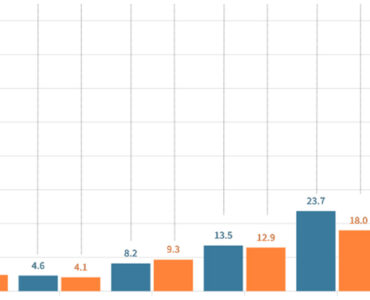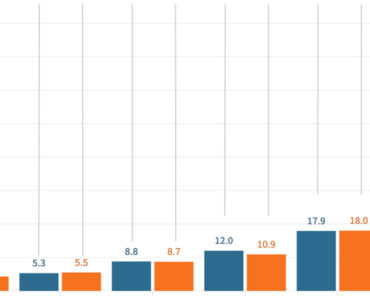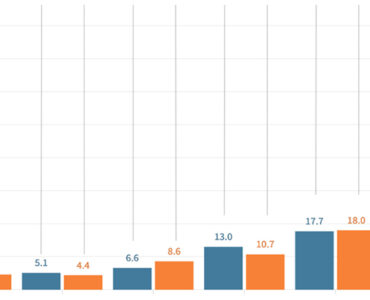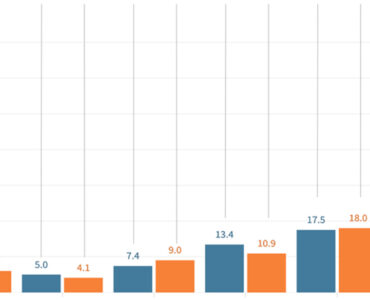Purpose
The goal of this policy brief is to inform and address the rising inflation in Turkmenistan and initiate an informed and constructive discussion on inflation among the policymakers and public in Turkmenistan. Based on estimates, which will be discussed below in details, inflation in Turkmenistan has been in double digits and sometimes in triple digits since 2016, which negatively impacted the lives of people in the country. The government of Turkmenistan does not admit the existence of high inflation, nor does it disclose any statistics related to inflation in the country or have a stated government policy to curb inflation. Therefore, the purpose of this brief is first to estimate the existing level of inflation, secondly, to look at the root causes of the problem, and lastly, to develop recommendations for addressing inflation. This research is prepared by our analytics team at Progres.online using information on Turkmenistan from publicly available sources.
Background
The government of Turkmenistan does not share any economic indicators related to the health of the economy other than mentioning percentage growth of GDP every year without reporting the absolute value of annual GDP. Therefore, we have to rely on various international reports to assess the economic situation in Turkmenistan. Since 2016, Turkmenistan has been experiencing economic turmoil mainly due to overdependence on the exports of natural gas and budgetary constraints inflicted by mismanagement. The economy has been characterized by high inflation rates and the emergence of a parallel exchange rate regime. Below are some economic indicators concerning inflation in Turkmenistan:
- The share of hydrocarbons within total annual exports was 86.3% in 2020, of which 76.5% comes from the exports of natural gas. The remaining share of exports consists of ships (2.82%), cotton (2.5%), fertilizers (2.5%), plastic (2%), and others (OEC). Thus, the share of the non-mineral sector in the economy is only 13.7% of the total exports, indicating a huge overdependence of the economy on the exports of natural resources. When gas prices collapsed in international markets between 2014-2016, the economic crisis unfolded in the country.
- According to IMF data, the GDP of Turkmenistan reached its peak in 2014 at 55.5 billion USD and went down dramatically to 41.7 billion USD in 2016, which is a 24.9% decrease. Such a big decline was driven by the lower prices of natural gas and halting gas exports from Turkmenistan to Russia and Iran. Such a big contraction in the GDP has only recovered in 2021 by reaching a 63.4 billion USD. Prices of natural gas increased dramatically in 2021 by almost reaching the record high prices of 2014. Therefore, increased price of natural gas could have contributed to the growth of GDP of Turkmenistan in 2021.
- Based on the World Bank data, export volumes also faced a similar decline from 20.3 billion USD in 2014 to 8 billion USD in 2016 in just two years (60% decline) due to the lower prices of natural gas and halting gas exports to Russia and Iran. The latest data from the World Bank is only available for 2018, in which export levels stood at 9.2 billion USD.
- Lower prices for Turkmenistan’s primary export commodity meant that less foreign exchange was coming in, putting pressure on the local currency to depreciate. To avoid depreciation, the government imposed restrictions on currency exchange. These measures failed to stop actual depreciation, while effectively creating conditions for the emergence of a parallel exchange rate market. As a result, the total volume of annual imports in Turkmenistan declined from the peak of 19.3 billion USD in 2014 to 5.1 billion USD in 2018, which is almost four times lower (World Bank).
Before the restrictions took place, the local manat was pegged against the US dollar at 3.5 manat. It has now reached 19.5 manat in the black market, as of 8 May 2022 (HronikaTM), which is 5.5 times higher. Thus, as a result of the higher exchange rate, imported products became more expensive. Domestic production did not compensate for the decline in imports and could not keep up with the demand. As a result, shortages of products and inflation occurred. Nevertheless, the government has recently stated that the country “maintains financial and social stability“. Such an optimistic statement, however, fails to consider the current high inflation rates, which particularly hit hard the people in the lowest income brackets. Since the government does not acknowledge and report the poverty statistics to the public and international institutions, it is difficult to estimate exactly the effects of inflation on domestic welfare. Yet, based on the experience of other countries, inflation rates that are above single digit typically have severe welfare implications.
Increased prices, in particular food prices, have a direct correlation with welfare and poverty, in particular for low-income households, who devote a high share of their budget to food. On average, people in Turkmenistan spend 52% of their monthly income (United Nations) on food products. This is slightly higher than the share of food in consumption in Uzbekistan (30%) and Kazakhstan (43%). To compare, people in western countries spend less than 15% of their income on food. Given this information, the increase in food prices would have a profound impact on the purchasing power of Turkmen households, especially the most vulnerable parts of the population.
The dynamics of the inflation
Despite the lack of official data, there are several estimates from international organizations on the value of inflation in Turkmenistan. IMF measured annual inflation in Turkmenistan at 15% in 2021, while Asian Development Bank’s (ADB) measurement put it at 12.5% for the same year. IMF’s annual inflation forecasts for the country for 2022 and 2023 stand at 17.5% and 10.5%, respectively. The World Bank, on the other hand, has stopped publishing economic output, income, or growth data for Turkmenistan in its publications since 2020 due to the lack of reliable data of adequate quality.
Our initiative Progres.online, a Turkmen think tank, has been tracking inflation by developing and using an alternative instrument – Palaw Index, which allows our researchers to calculate inflation in Turkmenistan using the prices of ingredients for a traditional Turkmen dish, palaw, by tracking the changes in prices of its main ingredients: meat, flour, cooking oil, rice, carrots, onion. According to the Palaw Index, the annual inflation rate (that is compared to the same month of the previous year) in Turkmenistan was 45% in January, 20% in February and 16% in March of 2022.
Professor Steve Hanke from Johns Hopkins University reported that the average annual inflation rate in Turkmenistan in 2017 was 50%, then it reached as high as 294% in June of 2018 and dropped to 31% in 2020. According to an internationally accepted definition, an inflation rate that is above 50% year-on-year is characterized as hyperinflation. According to our Index, Turkmenistan came very close to a hyperinflation episode in January 2022, while Professor Hanke’s estimates point to hyperinflation episodes taking place in 2017-2018.
Exchange rate and inflation
Based on our research, the recent exchange rate fluctuation in the country has had a high impact on inflation rates in Turkmenistan. The country’s main exports are natural gas, through which Turkmenistan generates a significant amount of revenue relative to the size of its economy. Foreign currencies generated through gas exports helped the country to maintain an exchange rate of 3.5 manats against 1 USD. However, once the export revenue from the sales of gas drops, it significantly affects the foreign cash reserves of the country, putting an upward pressure on the local currency to devalue. Foreign exchange reserves are the foreign currencies (mainly USD) held by the Turkmen Central Bank. One of the major reasons for banks to hold such reserves is to manage their currency’s value. These assets serve as backup funds in case the Turkmen manat rapidly devalues or becomes insolvent. A shortage in foreign currency leads to the depreciation of the local currency. The government insisted on keeping the exchange rate at 3.5 manat/USD and significantly limited its free exchange, which led to the creation of the black market in which exchanging dollars became 5.5 times more expensive as of writing this brief.
Moreover, when the Turkmen manat is weaker, in relation to the USD, it stimulates exports and makes imports more expensive. For instance, the black-market rate of 19.5 manat per dollar reflects a weak domestic currency. However, since Turkmenistan mainly exports raw natural resources such as oil and gas, which do not employ many people, such exports do not result in increased income for the people. A sizeable share of the workforce in Turkmenistan is employed in the agricultural sector (21% as of 2019, according to the World Bank). Hence, the high inflation rate makes it expensive for Turkmen consumers to buy foreign goods and services, including travelling or studying abroad.
Dealing with high inflation: what are the potential solutions to solve this problem?
Dealing with rising inflation should be one of the major priorities of the new government in Turkmenistan and therefore, we lay out our recommendations for Turkmen policy makers in addressing the inflation. Having two parallel exchange rates in the country contributes to price instability, as it distorts the markets for both exports and imports, making international transactions more difficult and affecting supply. Thus, in order to stabilize the price level in the country, the first recommendation would be to align the two exchange rates and make foreign currencies available for the public to exchange freely. At the same time, to deal with the underlying reasons for inflation, the government should consider lowering the total government spending in the medium term; commit to trade openness; consider long-term measures to increase domestic production; as well as to diversify the production away from natural gas and petrochemicals.
Unify the two exchange rates (IMF): Turkmenistan has two different exchange rates: the official exchange rate that is restricted, and the black market exchange rate, which is accessible to everyone and is almost 5.5 times more expensive. Some companies with connections to the government have access to convert their money via the official exchange rate, while others are excluded from this opportunity (Gündogar). However, this process is opaque, involves corruption and occurs on a limited scale. Converting currencies per official exchange rate is also unavailable to small and medium enterprises since the government picks winners and losers by providing preferential access to an official exchange rate. The creation of the expensive black market exchange rate might be the biggest reason behind higher inflation and hence the solution to this problem should certainly involve a unification of two different exchange rates. It can be either pegged to the US dollar again at a devalued rate somewhere between the current official and parallel rates or might be floated where the value of the currency is determined by supply and demand.
Donate to support Turkmen analysts, researchers and writers to produce factual, constructive and progressive content in their efforts to educate the public of Turkmenistan.
SUPPORT OUR WORKProfessor Steve Hanke proposes currency boards for developing countries facing high inflation rates due to weak domestic currencies. Under the currency board, domestic currency can be issued only to the extent that it is fully covered by the central bank’s holdings of foreign exchange and the exchange rate is fixed to a strong international currency. Whichever approaсh is used, it is imperative that the exchange rate stays stable and trusted by businesses owners, investors, and the public at large. It will be difficult to achieve any progress without addressing the two exchange rates.
Tighten fiscal policy (Institute of International Finance): The tight fiscal policy usually includes actions like lowering government spending and increasing tax rates. Increasing taxes during an economic crisis with high inflation rates in the case of Turkmenistan might do more harm than good given the sheer number of people living in poverty. Therefore, we will concentrate on re-prioritizing government spending as a tool to tighten fiscal policy. The government in Turkmenistan has been spending a significant amount of money on infrastructure projects by building luxury hotels, airports, monuments, hosting multi-billion dollar Asian games, and other grand projects. Turkmenistan reportedly spent around 10 billion USD to host the Asian indoor games (AIMAG) in 2017, which was approximately 21.5% of the national GDP in 2017. The government is currently spending over 37 billion USD for 2500 different construction projects over the period from 2019 to 2022, which takes around 14-17% of the national GDP in each year. Thus, the government keeps spending an enormous amount of money in a non-transparent manner on various construction projects, which at best can raise national GDP only in the short-term. The re-prioritization of fiscal spending would move away from expensive infrastructure projects that are subject to corruption towards more targeted spending on small and medium size enterprises, development, education, health, as well as building infrastructure to facilitate inter-regional trade. According to Progres.online’s estimates, the share of government spending reached 50% of the national GDP in 2020, which is quite significant for a non-industrialized developing country like Turkmenistan. For comparison, the share of government spending is 24.3% of the national GDP in Kazakhstan and 27.9% in Uzbekistan. Therefore, the role of the government in the economy needs substantial rethinking and reform. The budget is not publicly debated and no details other than the total revenue and expenditure are shared in the national media. New spending proposals should be debated in the parliament and once they pass, an independent expert committee should be formed to oversee their implementation to make the process transparent and accountable.
Enhance trade openness, lower tariffs, and reduce other trade barriers (WTO): another way to reduce the impact of high inflation rates and expensive exchange rates might be to lower trade restrictions including import tariffs, quotas, and other trade barriers. Import restrictions coupled with higher exchange rates will increase the price of goods even further and these extra costs will be passed on to the consumers. Tariff rates for imports are not publicly shared by the government and the latest data has not been updated since 2002 on the website of the World Integrated Trade Solutions (WITS). Based on the 2002 data, some food products have the following tariff rates: cheese 20%, eggs 10%, potatoes 20%, tomatoes 100%, onions 100%, carrots 100%, cucumbers 100%, and mushrooms 50%. Many other products were also included.
Attract foreign investments to increase domestic production of goods and services: Opening and operating small and medium-sized private businesses should be made easier by reducing the bureaucratic procedures involved in the process. Turkmenistan ranks among the bottom 11 of the most corrupt countries in the world according to the Corruption Perception Index. Corruption is a symptom of government overregulation and bureaucracy. The government also gives licenses to operate large factories to certain individuals, which distorts the real competition and allows monopolists to charge high prices. Moreover, domestic production, especially in the manufacturing and agricultural sectors, requires raw materials and inputs from abroad. Therefore, free and stable exchange rates along with lower trade barriers are also helpful for domestic producers. Once all domestic and trade barriers are removed, more factories can be built, which can lower prices. Diversification of domestic production away from natural resources might also be helpful given the price volatility of commodities.
The existence of an overvalued official exchange rate and a black market parallel rate will also make it difficult to attract foreign direct investments (FDI), as it additionally encourages rent-seeking and is hindering business development. Attracting FDI is especially important as it brings higher investment from abroad, creates jobs, transfers technology and know-how and increases domestic production. In 2020, inflows of FDI to Turkmenistan decreased by 45% and were at $1.2 billion. The country’s export revenues and investment projects have also declined significantly during the COVID-19 pandemic given the fall in international demand for hydrocarbons.
Introducing systemic reforms towards democracy: many proposed reforms require political will, government’s commitment to accountability and functioning democratic institutions. Freedom House classifies Turkmenistan as a consolidated authoritarian regime by giving it 2 points out of the total 100 by placing the country as one of the closed and the most authoritarian countries in the world.
Conclusion
High inflation resulting from an economic crisis in Turkmenistan created many societal problems by leaving thousands of households in poverty. Thus, addressing inflation should be one the urgent priorities of the new government in Turkmenistan. Progres.online has proposed potential solutions to solve this problem such as unifying the two exchange rates, tightening fiscal policy, enhancing trade openness, increasing domestic production of goods and services, and introducing systemic reforms towards openness and democracy.






